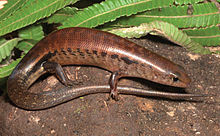| Pinoyscincus abdictus | |
|---|---|

| |
| Conservation status | |
 Least Concern (IUCN 3.1) | |
| Scientific classification | |
| Domain: | Eukaryota |
| Kingdom: | Animalia |
| Phylum: | Chordata |
| Class: | Reptilia |
| Order: | Squamata |
| Family: | Scincidae |
| Genus: | Pinoyscincus |
| Species: | P. abdictus |
| Binomial name | |
| Pinoyscincus abdictus (W. Brown & Alcala, 1980) | |
| Synonyms | |
Pinoyscincus abdictus is a species of skink, a lizard in the family Scincidae. The species is endemic to the Philippines. There are two recognized subspecies.
Habitat
The preferred natural habitat of P. abdictus is forest, at altitudes from sea level to 1,000 m (3,300 ft).
Reproduction
The mode of reproduction of P. abdictus is unknown.
Subspecies
Two subspecies are recognized as being valid, including the nominotypical subspecies.
- Pinoyscincus abdictus abdictus (W. Brown & Alcala, 1980)
- Pinoyscincus abdictus aquilonius (W. Brown & Alcala, 1980)
Nota bene: A trinomial authority in parentheses indicates that the subspecies was originally described in a genus other than Pinoyscincus.
References
- ^ Brown, R.; Diesmos, A. (2009). "Pinoyscincus abdictus". IUCN Red List of Threatened Species. 2009: e.T169837A6680470. doi:10.2305/IUCN.UK.2009-2.RLTS.T169837A6680470.en. Retrieved 19 November 2021.
- ^ Pinoyscincus abdictus at the Reptarium.cz Reptile Database. Accessed 22 March 2020.
Further reading
- Brown WC, Alcala AC (1980). Philippine Lizards of the Family Scincidae. Dumaguete, Philippines: Silliman University Natural Science Monograph Series. x + 246 pp. (Sphenomorphus abdictus, new species; S. abdictus aquilonius, new subspecies).
- Linkem CW, Diesmos AC, Brown RM (2011). "Molecular systematics of the Philippine forest skinks (Squamata: Scincidae: Sphenomorphus): testing morphological hypotheses of interspecific relationships". Zoological Journal of the Linnean Society 163 (4): 1217–1243. (Pinoyscincus abdictus, new combination).
| Taxon identifiers | |
|---|---|
| Pinoyscincus abdictus | |
This skink article is a stub. You can help Misplaced Pages by expanding it. |